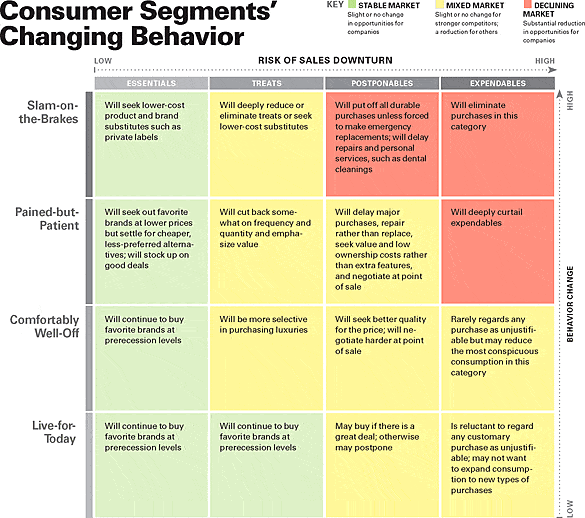Marketing in a downturn is tough for even the most experienced professionals. In studying the marketing successes and failures of dozens of companies, as they’ve navigated recessions, there are identified patterns in consumer behaviour which deliver strategies that can magnificently propel performance. This guide delivers an understanding of the evolving consumption patterns so you can fine-tune your strategy accordingly.
During recessions, of course, consumers set stricter priorities and reduce their spending. As sales start to drop, businesses typically cut costs, reduce prices, and postpone new investments. Marketing expenditures in areas from communications to research are often slashed across the board—but such indiscriminate cost-cutting is a mistake.
Although it’s wise to contain costs, failing to support brands or examine core customers’ changing needs can jeopardise performance over the long term. Companies that put customer needs under the microscope, take a scalpel rather than a cleaver to the marketing budget, and nimbly adjust strategies, tactics, and product offerings in response to shifting demand are more likely than others to flourish both during and after a recession.
Understanding Recession Psychology
In halcyon periods of prosperity, marketers may forget that rising sales aren’t caused by clever advertising and appealing products alone. Purchases depend on consumers’ having disposable income, feeling confident about their future, trusting in business and the economy, and embracing lifestyles and values that encourage consumption.
The wave of bad economic news is eroding confidence and buying power, driving consumers to adjust their behaviour in fundamental and perhaps permanent ways.
The first step in responding must be to understand the new customers that emerge in a recession. In a recession, such people may be less relevant than a psychological mindset that takes into consideration consumers’ emotional reactions to the economic environment.
Think of your customers as falling into four groups:
The slam-on-the-brakes ones are the most vulnerable and hardest hit financially. This group reduces all types of spending by eliminating, postponing, decreasing, or substituting purchases. Although lower-income consumers typically fall into this group, anxious higher-income consumers can as well, particularly if health or income circumstances change for the worse.
Pained but patient consumers tend to be resilient and optimistic about the long term but less confident about the prospects for recovery in the near term or their ability to maintain their standard of living. Like slam-on-the-brakes consumers, they economise in all areas, though less aggressively. They constitute the largest group and include the great majority of households unscathed by unemployment, representing a wide range of income levels. As news gets worse, pained but patient consumers increasingly migrate into the slam-on-the-brakes group.
Comfortably well-off consumers feel secure about their ability to ride out current and future bumps in the economy. They consume at near-prerecession levels, though now they tend to be a little more selective (and less conspicuous) about their purchases. The group consists primarily of people in the top 5% income bracket. It also includes those who are less wealthy but feel confident about the stability of their finances—the comfortably retired, for example, or investors who got out of the market early or had their money in low-risk investments.
The live-for-today segment carries on as usual and for the most part, remains unconcerned about savings. The consumers in this group respond to the recession mainly by extending their timetables for making major purchases. Typically urban and younger, they are more likely to rent than to own, and they spend on experiences rather than stuff (except consumer electronics). They’re unlikely to change their consumption behaviour unless they become unemployed.
Regardless of which group consumers belong to, they prioritise consumption by sorting products and services into four categories:
- Essentials are necessary for survival or perceived as central to well-being.
- Treats are indulgences whose immediate purchase is considered justifiable.
- Postponables are needed or desired items whose purchase can be reasonably put off.
- Expendables are perceived as unnecessary or unjustifiable.
All consumers consider basic levels of food, shelter, and clothing to be essentials, and most would put transportation and medical care in that category. Beyond that, the assignment of particular goods and services to the various categories is highly idiosyncratic.
Throughout a downturn, all consumers except those in the live-for-today segment typically re-evaluate their consumption priorities. We know from previous recessions that such products and services as restaurant dining, travel, arts and entertainment, new clothing, new cars, appliances, and consumer electronics can quickly shift in consumers’ minds from essentials to treats, postpones, or even expendables, depending on the individual.
As priorities change, consumers may altogether eliminate purchases in certain categories, such as household services (cleaning, gardening), moving them from essentials, say, into expendables. Or they may substitute purchases in one category for purchases in another, perhaps swapping dining out (a treat) for cooking at home (an essential). And because most consumers become more price-sensitive and less brand loyal during recessions, they can be expected to seek out favourite products and brands at reduced prices or settle for less-preferred alternatives. For example, they may choose cheaper private labels or switch from organic to non-organic foods.

Managing Marketing Investments
During recessions, it’s more important than ever to remember that loyal customers are the primary, enduring source of cash flow and organic growth. The people are already on your database. Marketing isn’t optional—it’s a “good cost,” essential to bringing in revenues from these key customers and others.
Still, company budget cuts often affect marketing disproportionately. Marketing communication costs can be trimmed more quickly than production costs—and without letting people go. In managing their marketing expenses, however, businesses must take care to distinguish between the necessary and the wasteful. Building and maintaining strong brands—ones that customers recognise and trust—remains one of the best ways to reduce business risk.
Surgically trimming the budget and future-proofing your economic future is easier to do during a downturn than in prosperous times. Tough times provide an imperative to cut loose poor performers and eliminate low-yield tactics. When survival is at stake, it is easier to get companywide buy-in for revising marketing strategies and reallocating investments. Managers can defy old mindsets and creatively search for superior solutions to customer needs instead of relying on the next-line extension. The challenge is to make well-defended, case-by-case recommendations about where to cut spending, where to hold it steady, and even where to increase it.
Assess opportunities.
Begin by performing triage on your brands and products or services. Determine which have poor survival prospects, which may suffer declining sales but can be stabilised, and which are likely to flourish during the recession and afterwards. Look to the highest returns in ROI, and take advantage of opportunities instead of sitting on your laurels.
Your strategic opportunities during the downturn will strongly depend on which of the four segments your core customers belong to and how they categorise your products or services. For example, prospects are reasonably good for value-brand essentials sold to slam-on-the-brakes consumers, who will forgo premium brands in favour of lower prices. Hyper-personalisation is critical in the new world order, not trivial personalisation like segmentation, which isn’t personalisation at all, or geo-constrained age profiling. Instead, we mean the use of AI software to identify imminent consumer purchases, which selects products unique to that individual, predicted to be their next imminent purchase, thereby increasing AOV, and CLV and reducing RoR. Those merely restricting their efforts to traditional ESP software will fall short.
Value brands can also effectively reach out to pained but patient consumers who previously bought higher-end brands, a strategy WalMart aggressively used with its “everyday low prices” policy in the 2001 recession. Value brands have opportunities with postponable products, as well. Repair services can market to the pained but patient group, who will try to prolong the life of a refrigerator rather than buy a new one.
Where the business opportunities are uncertain or declining, it may be time to part with brands or products that were ailing before the recession and are on life support now. For those that remain, companies should concentrate their marketing resources on maintaining relevance to core customers to sustain brands through the recession and into the recovery.
Allocate for the long term.
When sales start to decline, companies shouldn’t panic and alter a brand’s fundamental proposition or positioning. For instance, marketers catering to middle- or upper-income consumers in the pained-but-patient segment may be tempted to move down-market. This could confuse and alienate loyal customers; it could also provoke stiff resistance from competitors whose operations are geared to a low-cost strategy and who have intimate knowledge of cost-conscious customers.
Marketers that drift away from their established base may attract some new customers in the near term but find themselves in a weaker position when the recession ends. Their best course is to stabilise the brand. Even cash-poor firms would be wise to commit a substantial portion of their marketing resources to reinforce the core brand proposition. Reminding consumers of how the brand matters can add to the cushion provided by previous investments in building the brand and customer satisfaction.
De Beers came to this realisation after it reduced its marketing budget early in 2008 in response to the grim economic outlook. When research revealed that diamonds represent enduring value to a majority of consumers, the company doubled its Christmas advertising spending over the previous year. Brand-awareness ads in several media proclaimed, “Here’s to less,” and enjoined us to buy “fewer, better things” because “a diamond is forever.” Although Christmas sales softened compared with the previous year’s, prices were stable—and trends in consumers’ desire to buy diamonds remained healthy.
Where opportunities are stable or uncertain (but leaning toward stability), firms should push their advantage. In past downturns, consumer goods companies that were able to increase their share of voice by maintaining or increasing their advertising spending captured market share from weaker rivals. What’s more, they did it at a lower cost than when times were good.
On average, increases in marketing spending during a recession have boosted financial performance throughout the year following the recession. (Of course, not all increases have raised performance. Therefore, especially in the current, deep recession, resources should be judiciously targeted to viable business opportunities.) Firms with deep pockets can make cost-effective acquisitions that strengthen their brand portfolio or customer base.
In the 2001 downturn, Smucker’s acquired the Jif and Crisco brands from Procter & Gamble. These brands were too small for P&G and not in any of its core categories, but they proved to be a good strategic fit for Smucker’s. In the current recession, Smucker’s is acquiring another such brand from P&G—Folgers. Though it does not meet P&G’s margin targets, with renewed marketing attention it has the potential to be an important source of future sales for Smucker’s.
In deciding which marketing tactics to employ, it’s critical to track how customers are reassessing priorities, reallocating budgets, switching among brands and product categories, and redefining value. It’s therefore essential to continue investing in market research. As the recession winds down, consumers will regain buying capacity but possibly will not return to their old purchasing patterns. Market research should explore whether consumers will go back to familiar brands and products, stay with substitute products, or welcome innovations.
It’s critical to track how customers reassess priorities, reallocate funds, switch brands, and redefine value.
In recessions, marketers have to stay flexible, adjusting their strategies and tactics on the assumption of a long, difficult slump and yet be able to respond quickly to the upturn when it comes. This means, for example, having a pipeline of innovations ready to roll out on short notice. Most consumers will be ready to try a variety of new products once the economy improves.
Companies that wait until the economy is in full recovery to ramp up will be at the mercy of better-prepared competitors. Even during a recession, new products have an important place. Live-for-today customers, with their undiminished appetite for goods and experiences, often appreciate novelty. And the other groups will embrace new products that offer clear value compared with alternatives.
Because new-product activity slows in recessions overall, launches can economically gain visibility. In 2001, for example, Procter & Gamble’s successful introduction of the Swiffer WetJet established a new product category that eased the chore of mopping floors and weaned consumers away from cheaper alternatives.
Balance the communications budget.
During recessions, cash-strapped marketing departments are under pressure to do more with less and demonstrate high returns on investment. Typically, the share of the advertising budget devoted to broadcast media shrinks, whereas the share that goes toward efforts with more measurable results, such as direct marketing campaigns and online ads, grows. Point-of-purchase marketing—promoting price cuts or generating in-store excitement—also tends to pick up during recessions.
Positioning for Recovery
Survivors who make it through this recession by focusing their attention on consumer needs and core brands will be strongly positioned for sunnier days ahead. However, companies must understand how people’s behaviour may change following the recession so they will be able to offer products and communicate messages aligned with the needs of new consumer segments.
After most recessions have ended, consumers’ attitudes and behaviours return to “normal” within a year or two. Following more extreme downturns, though, consumers’ heightened sense of economic vulnerability can persist for a decade or longer. The deeper and more prolonged a recession is, the greater the possibility that there will be profound transformations in consumers’ attitudes and values. Witness the long-lasting caution regarding consumption characterising Americans who lived through the Great Depression or present-day Japanese who endured a stagnant economy throughout the 1990s.
Usually, repercussions are not so extreme as that. In the United States, postwar recessions have lasted an average of 10 to 11 months. The harshest was the 16-month-long recession of 1973–1975, during which consumption growth was –0.9%, and the 18-month “double-dip” recession of 1980 and 1981–1982, during which consumption growth was negative in the first dip but rebounded in the second. The last recession, in 2001, saw no decline in overall consumer spending, although many individuals cut back.
However, the current recession, as noted, is unusually severe, and consumer confidence and trust in business are at record-breaking lows. Given these facts, there is a good possibility that consumer attitudes and behaviour shaped during this recession will linger substantially beyond its end. While the comfortably well-off and live-for-today segments may carry on as usual, the slam-on-the-brakes and pained-but-patient segments—by far the large majority of consumers—may well retain the consumption habits they’ve learned.
They’ll seek value and trusted brands, remain considered in their purchases of treats, and continue to delay purchases of postponables. Consumers can also be expected to retain their distrust of business, an attitude forged by the corporate malfeasance that fuels this recession.





